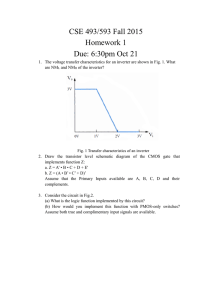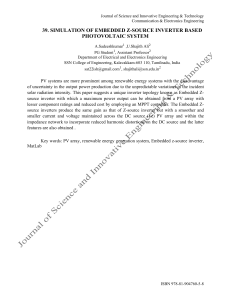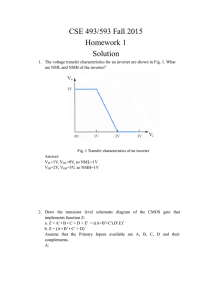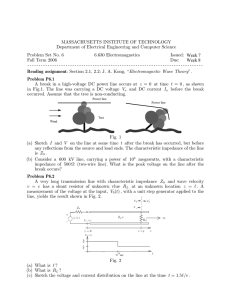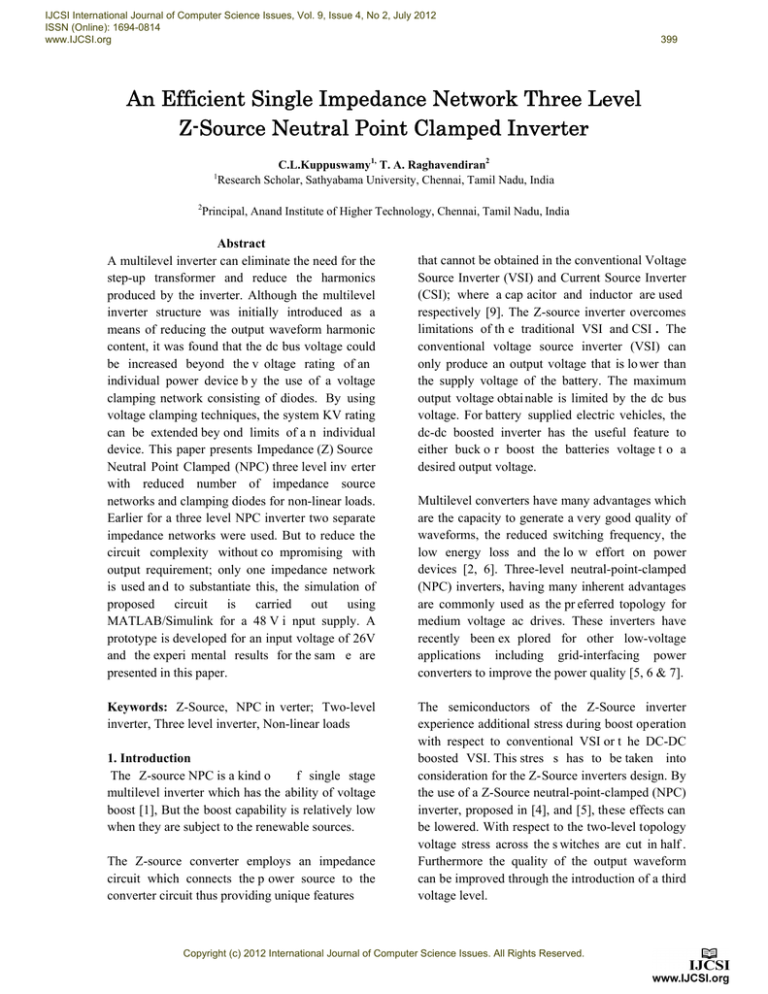
IJCSI International Journal of Computer Science Issues, Vol. 9, Issue 4, No 2, July 2012
ISSN (Online): 1694-0814
www.IJCSI.org
399
An Efficient Single Impedance Network Three Level
Z-Source Neutral Point Clamped Inverter
C.L.Kuppuswamy1, T. A. Raghavendiran2
Research Scholar, Sathyabama University, Chennai, Tamil Nadu, India
1
2
Principal, Anand Institute of Higher Technology, Chennai, Tamil Nadu, India
Abstract
A multilevel inverter can eliminate the need for the
step-up transformer and reduce the harmonics
produced by the inverter. Although the multilevel
inverter structure was initially introduced as a
means of reducing the output waveform harmonic
content, it was found that the dc bus voltage could
be increased beyond the v oltage rating of an
individual power device b y the use of a voltage
clamping network consisting of diodes. By using
voltage clamping techniques, the system KV rating
can be extended bey ond limits of a n individual
device. This paper presents Impedance (Z) Source
Neutral Point Clamped (NPC) three level inv erter
with reduced number of impedance source
networks and clamping diodes for non-linear loads.
Earlier for a three level NPC inverter two separate
impedance networks were used. But to reduce the
circuit complexity without co mpromising with
output requirement; only one impedance network
is used an d to substantiate this, the simulation of
proposed
circuit
is
carried
out
using
MATLAB/Simulink for a 48 V i nput supply. A
prototype is developed for an input voltage of 26V
and the experi mental results for the sam e are
presented in this paper.
Keywords: Z-Source, NPC in verter; Two-level
inverter, Three level inverter, Non-linear loads
1. Introduction
The Z-source NPC is a kind o
f single stage
multilevel inverter which has the ability of voltage
boost [1], But the boost capability is relatively low
when they are subject to the renewable sources.
The Z-source converter employs an impedance
circuit which connects the p ower source to the
converter circuit thus providing unique features
that cannot be obtained in the conventional Voltage
Source Inverter (VSI) and Current Source Inverter
(CSI); where a cap acitor and inductor are used
respectively [9]. The Z-source inverter overcomes
limitations of th e traditional VSI and CSI . The
conventional voltage source inverter (VSI) can
only produce an output voltage that is lo wer than
the supply voltage of the battery. The maximum
output voltage obtai nable is limited by the dc bus
voltage. For battery supplied electric vehicles, the
dc-dc boosted inverter has the useful feature to
either buck o r boost the batteries voltage t o a
desired output voltage.
Multilevel converters have many advantages which
are the capacity to generate a very good quality of
waveforms, the reduced switching frequency, the
low energy loss and the lo w effort on power
devices [2, 6]. Three-level neutral-point-clamped
(NPC) inverters, having many inherent advantages
are commonly used as the pr eferred topology for
medium voltage ac drives. These inverters have
recently been ex plored for other low-voltage
applications including grid-interfacing power
converters to improve the power quality [5, 6 & 7].
The semiconductors of the Z-Source inverter
experience additional stress during boost operation
with respect to conventional VSI or t he DC-DC
boosted VSI. This stres s has to be taken into
consideration for the Z-Source inverters design. By
the use of a Z-Source neutral-point-clamped (NPC)
inverter, proposed in [4], and [5], these effects can
be lowered. With respect to the two-level topology
voltage stress across the s witches are cut in half .
Furthermore the quality of the output waveform
can be improved through the introduction of a third
voltage level.
Copyright (c) 2012 International Journal of Computer Science Issues. All Rights Reserved.
IJCSI International Journal of Computer Science Issues, Vol. 9, Issue 4, No 2, July 2012
ISSN (Online): 1694-0814
www.IJCSI.org
Z-source NPC three level inverter with single Zsource network is more efficient compared to
conventional scheme where the number of
impedance networks requirement increases with
increase in t he number of input level. The present
paper aims at overcoming this drawback, where-in
irrespective of number of levels in ML I, a s ingle
impedance network along with clamping capacitors
is used. Therefore the i nductors in circuit are
reduced enabling compact and efficient design.
400
The proposed circuit to obtain same output levels
same as in circuit i n Fig.1 is shown in Fig.2. It
uses only one impedance network. The operation
is similar to circuit in Fig.1. The DC link voltages
are given by
2. Z-Source Three Level Inverter
The conventional Z-source NPC t hree level
inverter is shown in Fig.1. This circuit uses two
impedance networks as shown in Fig.1. The Zsource network can boost input DC voltage.
Consequently two boost factors can be defined for
Z-source NPC inverter as:
Fig.2 Proposed Z-source Three Level NPC inverter
3. Simulation Results
The
simulation
is carried o
ut
using
MATLAB/Simulink. The simulation circuit is
shown in Fig.3. Input is 48V DC which is shown in
Fig.4.
Fig.1 Conventional Three Level NPC Inverter
Where VoU, VoL are DC input voltages and Vi U,
ViL are DC link voltages. TSCOU, TSCOL and TSCB
are the shoot-through time intervals of only upper
z-source network output, only lower ou tput and
both outputs, respectively. For low output THD,
boost factors should be determined such that
voltage of both DC links of inverter would be the
same. In NPC inverter, if bo th DC links are the
same, equal powers are extracted from both DC
links.
Fig.3. Simulation circuit diagram of prosed Zsource Three Level NPC inverter
Copyright (c) 2012 International Journal of Computer Science Issues. All Rights Reserved.
IJCSI International Journal of Computer Science Issues, Vol. 9, Issue 4, No 2, July 2012
ISSN (Online): 1694-0814
www.IJCSI.org
401
V
o
l
t
s
V
o
l
t
s Fig.7 Per Phase Voltage in Three Legs T(ms)
Fig.4 DC input volatge
T(ms)
The gate pulses for MOSFET’s in first leg M1 –
M4 are shown in Fig.5. The phase output voltages
in Leg 1 are shown in Fig.6. The proposed inverter
Phase volatges in all three legs are shown in Fig.7.
The line voltages of proposed three phase three
level Z-source inverter are shown in Fig.8. Three
phase currents are shown in Fig.9. The FFT
analysis is done to find the Total Harmonic
Distortion (THD) and the FFT results are shown in
Fig.10
V
o
l
t
s As observed fro m Fig.7, three levels 110 V, 48 V
and Zero voltages are obtained.From this it is
concluded that a si ngle impedance network is
sufficient to obtain the required levels.
V
o
l
t
s
Fig.8 Line Voltages of proposed circuit T(ms) Fig.5 MOSFET Gate Pulses (I- Phase) T(ms)
V
o
l
t
s A
m
p
s
Fig.9 Three Phase Output Currents
Fig.6 Phase Voltages in Leg 1 (I-Phase)
T(ms) Copyright (c) 2012 International Journal of Computer Science Issues. All Rights Reserved.
T(ms) IJCSI International Journal of Computer Science Issues, Vol. 9, Issue 4, No 2, July 2012
ISSN (Online): 1694-0814
www.IJCSI.org
402
Fig.13 Output of Driver circuit.
Fig.10 FFT Analysis Results.
The THD is 12.42%.
4. Experimental Results
The experimental set up is shown in Fig.11. The
input voltage is 26V, which is shown in Fig. 12.
The output of driver circuit is shown in Fig.13. The
complementary switching pulses for upper and
lower switches are sh own in Fig.14. The inverter
output voltage is shown in Fig.15
Fig.14 MOSFET Switching pulses
Fig.11 Experimental Set up
Fig.15 Inverter Output voltage
5. Conclusion
Fig.12 Input voltage
A novel Z-source Three level NPC with single
impedance source network is proposed. As
observed from the simulation results from Fig.7 to
Fig.9, it is concluded that the proposed circuit can
replace the conventional Z-source NPC in verter
where two im pedance source networks are used.
Since the number of i nductors in the proposed
circuit are reduced, EMI is less and the circuit is
Copyright (c) 2012 International Journal of Computer Science Issues. All Rights Reserved.
IJCSI International Journal of Computer Science Issues, Vol. 9, Issue 4, No 2, July 2012
ISSN (Online): 1694-0814
www.IJCSI.org
simple and economical and more efficienct
compared to the conventional circuit. The THD of
proposed converter is 1 2.42%. The simulation
results are experimentally validated.This work can
be further extended to h igher levels t o minimize
the THD can be further reduced by increasing the
number of levels.
References
[1]. Ying Cheng, Chang Qian, Mariesa L. Crow,
Steve Pekarek, “A Comparison of Diode-Clamped
and Cascaded Multilevel Converters for a
STATCOM with Energy Storage” Industrial
Electronics, IEEE Transactions on Volu me 53,
Issue 5, Oct.2006 Page(s): 1512 – 1521.
[2] Said Barkati, Lotfi Baghli, EL Majid Berkouk,
Mohmed-Seghir Boucherit, "Harmonic elimination
in diode-clamped multilevel inverter using
evolutionary algorithms", Elsevier Electric Power
System Research, Vol. 78, pp. 1736-1746,2008.
[3] Ebrahim Babaei, Seyed Hossein Hosseini,
"New Cascaded Multilevel Inverter Topology with
Minimum Number of Switches", Elsevier E nergy
Conversion and Management, Vol. 50, pp. 27612767, 2009.
[4]. Jose Rodriguez, Steffen Bernet, Peter K.
Steimer, and Ignacio E. Lizama “A Survey on
Neutral-Point-Clamped
Inverters”
IEEE
TRANSACTIONS
ON
IN
DUSTRIAL
ELECTRONICS, VOL. 57, NO. 7, JULY 2010,
pp. 2219-2010.
[5].D. Floricau, E. Floricau, and G. Gateau,
“Three-level active NPC converter: PWM
strategies and loss distribution,” in Proc. IEEE
IECON,Nov. 2008, pp. 3333–3338.
[6]. J. I. Leon, S. Vaz quez, R. Portillo, L. G.
Franquelo, J. M. Carrasco,P. W. Wheeler, and A. J.
Watson, “Three-dimensional feed forward space
vector modulation applied to multilevel diodeclamped converters,” IEEE Trans. Ind. Electron.,
vol. 56, no. 1, pp. 101–109, Jan. 2009.
403
for low Output Voltage and regenerating
Operation”, 13th European Conference on Power
Electronics and Applications paper 0634, 2009
[8]. J. Rodriguez, L. G. Franquelo, S. Kouro, J. I.
Leon, R. C. Portillo, M. A. M. Prats, and M. A.
Perez, “Multilevel converters: An enabling
technology for high-power applications,” Proc.
IEEE, vol. 97, no. 11, pp. 1786–1817,Nov. 2009.
[9]. S.M. Dehghan E. Seifi M. Mohamadian R
Gharehkhani “Grid Conne cted DG Sy stems Based
on Z-Source NPC Inverters”, IEEE conference on
Power
Electronics,
Drive
systems
and
technologies, 2011, pp.104-111
[10] F. Z. Peng, M. Shen and K. Holland,
“Application of Z-Sourc e Inverter for Traction
Drive of Fuel Cell Battery Hybrid Electric
Vehicles,” IEEE Transactions on Power
Electronics, vol. 22, no. 3, pp. 1054-1061, 2007.
[11]. Diorge A. B. Zambra, CassianoRech and
José
RenesPinheiro,
Member
IEEE,
IEEETransactions on industrial electronics,
“Comparison
of Neutral
-Point-Clamped,
Symmetrical, and Hybrid Asymmetrical Multilevel
Inverters”JULY 2010
Authors Profile
C.L.Kuppuswamy received his M.E degree in
Power Electronics and Industrial Drives from
Sathyabama University, Chennai, India in 2010.
He is currently pursuing PhD in Electrical
Engineering at Sathyabama University, Chennai.
His research interests ar e Efficient C onverter for
high power applications and Multilevel Inverters.
Dr.T.A.Raghavendiran received his PhD degree
in Anna University, Chennai. He is having 32
years rich experience in Academic and I ndustries.
He has presented number of papers in the Journals
and International publications. He is p resently
working as P rincipal in Anand Institute of Higher
Technology, Chennai India. His area of interest
includes Power Quality, Drives & Energy Systems.
[7]. M. von Zimmer, M. L echler, B. Piepenbreier,
“Z-Source Drive Inverter using modified SVPWM
Copyright (c) 2012 International Journal of Computer Science Issues. All Rights Reserved.

